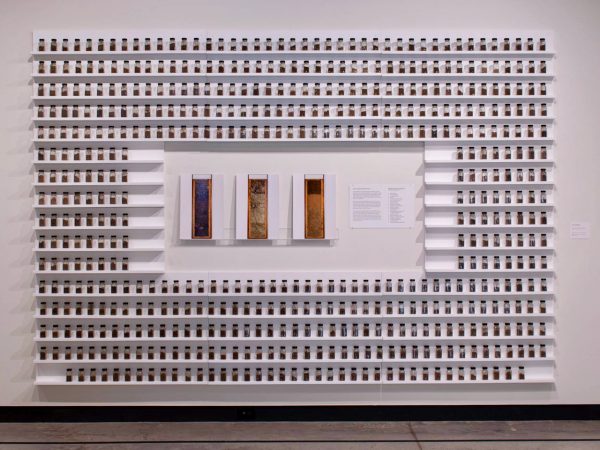Date/Time
Date(s) - April 20, 2022
12:00 pm - 1:00 pm
Location
Colorado State Powerhouse Campus
Mary Mattingly Artist Talk and Installation Unveiling
Join the Colorado State University Energy Institute and the Gregory Allicar Museum of Art for an artist talk by Mary Mattingly and the unveiling of her work in its new location.
The artist talk, unveiling, and reception celebrate the permanent installation of Mattingly’s artwork Post-Fossil Fuel Food Map (2021) at the Powerhouse Energy Campus, classroom 104 (430 N. College Avenue).
Mattingly will give a forty minute presentation followed by a brief audience Q&A. Light refreshments provided.
The artist talk will be recorded and uploaded afterwards to GAMA’s website and YouTube page.
Free and open to all.
About the installation:

Mary Mattingly is a multi-media, performance, and installation artist whose work centers on notions of sustainability as they relate to human systems. Based out of Brooklyn, New York, she is inspired by the complexities of urban environments and technology in questioning what it means to live a sustainable life. The infrastructure of food systems, and the role it plays in global warming is a recurring theme in Mattingly’s work. Projects such as SWALE, a public artwork and edible food forest that floats on a barge around New York City where it is illegal to pick foods on public lands, demonstrate her interest in local food systems that rely less on transportation. Mattingly focuses on regenerative agriculture in her work here and proposes that agriculture can be a solution to climate change, moving culture away from fossil fuel-derived pesticides and herbicides and simultaneously sequestering carbon in the soil used to grow our crops.
Post-Fossil Fuel Food Map (2021) was originally included in the exhibition Reclamation: Recovering Our Relationship with Place, curated by Associate Professor of Painting Erika Osborne and presented by the Gregory Allicar Museum of Art in collaboration with the Energy Institute at Colorado State University. The show was on view in the Griffin Foundation Gallery from July 7 to September 19, 2021, and was featured as part of the global art ruckus Extraction: Art on the Edge of the Abyss.
Support for this project was also generously provided by the City of Fort Collins Fort Fund, by the FUNd Endowment at CSU, and from Colorado Creative Industries. CCI and its activities are made possible through an annual appropriation from the Colorado General Assembly and federal funds from the National Endowment for the Arts. This project was also made possible, in part, through a grant from the Lilla B. Morgan Memorial Endowment, which works to enhance the cultural development and atmosphere for the arts at Colorado State University. This fund benefits from the generous support of all those who love the arts.
Funding for the current installation is provided by the Energy Institute and the Gregory Allicar Museum of Art at Colorado State University with support from the FUNd Endowment at CSU.
About the artist: Mary Mattingly
From the artist’s website:
Mary Mattingly is an interdisciplinary artist based in New York.
She founded Swale, an edible landscape on a barge in New York City. Docked at public piers but following waterways common laws, Swale circumnavigates New York’s public land laws, allowing anyone to pick free fresh food. Swale instigated and co-created the “foodway” in Concrete Plant Park, the Bronx in 2017. The “foodway” is the first time New York City Parks is allowing people to publicly forage in over 100 years. It’s currently considered a pilot project.
Mattingly recently launched Public Water with More Art and completed public artwork “Pull” with the Museo Nacional de Bellas Artes de la Habana and the Bronx Museum of the Arts, two spherical ecosystems that were pulled across Habana to Parque Central and the museum. In 2018 she received a commission from BRIC Arts Media to build “What Happens After” which involved dismantling a military vehicle (LMTV) that had been to Afghanistan and deconstructing its mineral supply chain. A group of artists including performance artists, veterans, and public space activists re-envisioned the vehicle for BRIC. In 2016 Mattingly facilitated a similar project with teens at the Museum of Modern Art.
Mary Mattingly’s artwork has also been exhibited at the Istanbul Biennale, the Havana Biennial, Storm King, the International Center of Photography, the Seoul Art Center, the Brooklyn Museum, the New York Public Library, deCordova Museum and Sculpture Park, and the Palais de Tokyo. With the U.S. Department of State and Bronx Museum of the Arts she participated in the smARTpower project, traveling to Manila. Mattingly has been awarded grants and fellowships from the James L. Knight Foundation, Eyebeam Center for Art and Technology, Yale University School of Art, the Harpo Foundation, NYFA, the Jerome Foundation, and the Art Matters Foundation.
Her work has been featured in Aperture Magazine, Art in America, Artforum, Art News, Sculpture Magazine, The New York Times, New York Magazine, Financial Times, Le Monde Magazine, Metropolis Magazine, New Yorker, The Wall Street Journal, the Brooklyn Rail, and on BBC News, MSNBC, NPR, WNBC, and on Art21.
It has been included in books such as the Whitechapel/MIT Press Documents of Contemporary Art series title “Nature” and edited by Jeffrey Kastner, Triple Canopy’s Speculations, the Future Is… published by Artbook, and Henry Sayre’s A World of Art, 8th edition, published by Pearson Education Inc. Mattingly’s artwork is represented by Robert Mann Gallery and currently, her sculpture can be seen in the Cuenca Bienale in Ecuador.